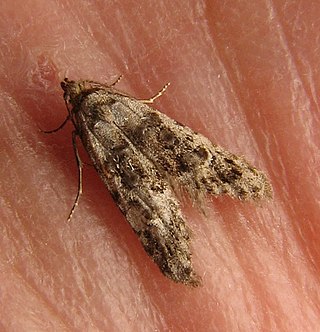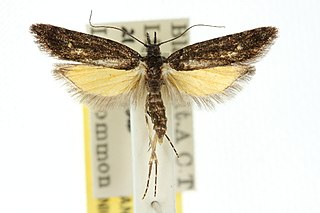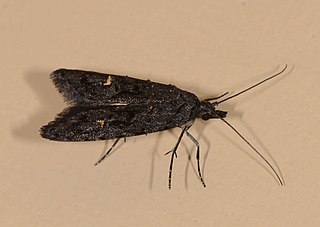
Anacampsis is a worldwide genus of moth with most found in the nearctic and neotropical regions. It is in the family Gelechiidae. The larvae feed on a range of deciduous trees and shrubs in a rolled or folded leaf, or spun shoot.

Dichomeris is a genus of moths in the family Gelechiidae erected by Jacob Hübner in 1818.

Bradina is a genus of moths of the family Crambidae.

Grapholita is a large genus of tortrix moths. It belongs to subfamily Olethreutinae, and therein to the tribe Grapholitini, of which it is the type genus.

The Autostichinae are a subfamily of moths in the superfamily Gelechioidea. Like their relatives therein, their exact relationships are not yet very well resolved. The present lineage was often included in the concealer moth family (Oecophoridae), but alternatively it is united with the Symmocidae sensu stricto to form an expanded family Autostichidae.

Autosticha is a genus of gelechioid moths. It belongs to the subfamily Autostichinae, which is either placed in the concealer moth family (Oecophoridae), or in an expanded Autostichidae. It is the type genus of its subfamily. Originally, this genus was named Automola, but this name properly refers to a fly genus in family Richardiidae.

Xyloryctidae is a family of moths contained within the superfamily Gelechioidea described by Edward Meyrick in 1890. Most genera are found in the Indo-Australian region. While many of these moths are tiny, some members of the family grow to a wingspan of up to 66 mm, making them giants among the micromoths.

Glyphipterix is a genus of sedge moths. It was described by Jacob Hübner in 1825.
Glyphipterix cyanochalca is a species of sedge moth in the genus Glyphipterix. It was described by Edward Meyrick in 1882. It is found in south-east Australia.

Bondia is a genus of moths in the Carposinidae family.
Commatarcha is a genus of moths in the Carposinidae family.

Bondia dissolutana is a moth in the family Carposinidae. It was described by Edward Meyrick in 1882. It is found in Australia, where it has been recorded from New South Wales.
Bondia maleficana is a moth in the family Carposinidae. It was described by Edward Meyrick in 1882. It is found in Australia, where it has been recorded from Queensland and New South Wales.

Bondia caseata is a moth in the family Carposinidae. It was described by Edward Meyrick in 1910. It is found in Australia, where it has been recorded from Victoria and South Australia.
Bondia digramma is a moth in the family Carposinidae. It was described by Edward Meyrick in 1910. It is found in Australia, where it has been recorded from Western Australia.

Bondia fidelis is a moth in the family Carposinidae. It was described by Edward Meyrick in 1913. It is found in North America, where it has been recorded from Arizona and Colorado.

Bondia nigella is a moth in the family Carposinidae. It was described by Newman in 1856. It is found in Australia, where it has been recorded from the eastern part of the country and Tasmania.
Heosphora is a genus of moths in the family Pyralidae. The genus was first described by Edward Meyrick in 1882. The type species is Anerastia psamathella Meyrick, 1879, designated as such by George Hampson in 1901. All Heosphora species are found in Australia.
Heosphora psamathella is a moth in the family Pyralidae. The species was first described by Edward Meyrick in 1879, as Anerastia psamathella, from a male specimen collected in Sydney, New South Wales, and was moved to the genus Heosphora as its type species by George Hampson in 1901. It is found in Australia.











